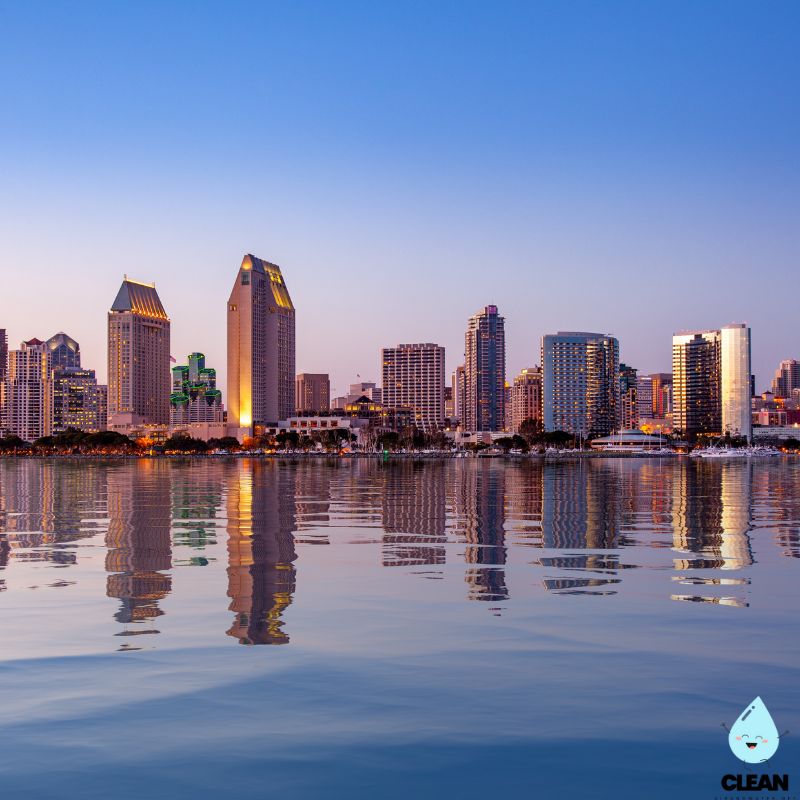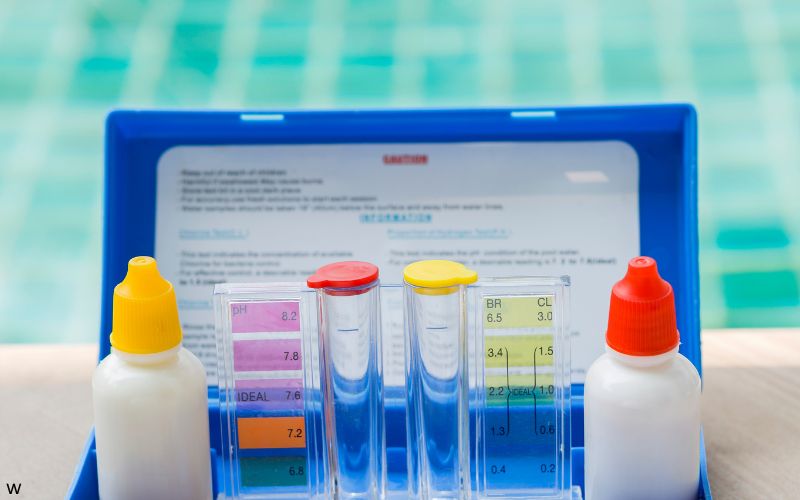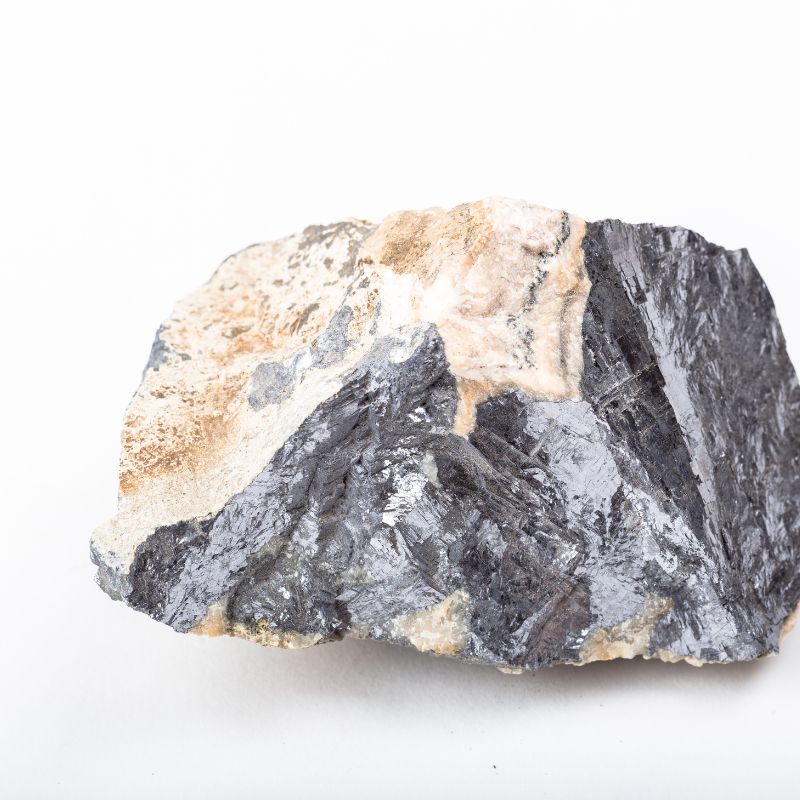San Diego Water Quality at a Glance
many contaminants present
Is San Diego Water Safe to Drink?
Meets Federal Standards with Concerns – San Diego water complies with EPA standards but contains 14 contaminants exceeding health guidelines. Key issues include disinfection byproducts like trihalomethanes (188× above guidelines), hexavalent chromium (2.2× above), PFAS chemicals, and uranium. The city uses multiple water sources including desalination and Colorado River water, with advanced treatment, but filtration is recommended for optimal health protection.
⚠️ Key Concerns for San Diego Residents
- Disinfection Byproducts: Total trihalomethanes 188× above health guidelines; haloacetic acids 362× above guidelines – formed during chlorine treatment
- PFAS “Forever Chemicals”: Multiple PFAS detected including PFOA and PFOS; Sweetwater Reservoir contamination affecting South County residents
- Heavy Metals & Carcinogens: Hexavalent chromium (Erin Brockovich chemical), uranium, and various disinfection byproducts linked to cancer risk
- Border Contamination: 2025 sewage spills from Mexico affecting beaches; up to 5 million gallons daily of untreated wastewater entering coastal waters
Read the full report below for detailed analysis, city-specific data, and actionable recommendations for San Diego residents.
San Diego – California – Water Quality Report 2025: PFAS Testing, Infrastructure Concerns & Safety across your city
San Diego’s Public Utilities Department provides comprehensive water and wastewater services to more than 1.4 million residents across America’s Finest City, operating nine reservoirs, three water treatment plants, three wastewater treatment plants, 131 pump stations, and over 6,300 miles of pipelines. As a semi-arid region that historically imports over 60% of its water from the Colorado River and Northern California Bay Delta, San Diego has invested over $3 billion in water supply diversification to achieve greater independence and reliability.
San Diego’s revolutionary approach includes the nation’s largest seawater desalination plant in Carlsbad, producing 50 million gallons daily, and the ambitious Pure Water San Diego program, which will provide nearly half the city’s water supply through advanced wastewater recycling by 2035. However, recent testing reveals 14 contaminants exceeding health guidelines, including disinfection byproducts at levels 188 times above recommended safety thresholds, PFAS “forever chemicals,” and hexavalent chromium. While the city’s multi-barrier water treatment processes ensure all drinking water meets federal and state quality standards, ongoing investments in infrastructure modernization and emerging contaminant monitoring demonstrate San Diego’s commitment to addressing these challenges for future generations.

San Diego Water Quality: Current Status (2024-2025)
Latest Testing Results
- Contaminant Detection: Environmental Working Group analysis shows 14 contaminants exceeding health guidelines in San Diego’s water, including total trihalomethanes at 188 times above recommended levels, haloacetic acids at 362 times above guidelines, and hexavalent chromium at 2.2 times above safety thresholds.
- PFAS Contamination: Multiple PFAS “forever chemicals” detected including PFOA at 0.104 ppt and PFOS at 0.096 ppt. South County residents face elevated risks from Sweetwater Reservoir contamination, with treatment costs potentially reaching $40 million or requiring reservoir decommissioning.
- Regulatory Compliance: San Diego’s water meets all federal and state drinking water standards, with comprehensive monitoring and transparent reporting through annual Consumer Confidence Reports. However, legal compliance does not necessarily equal optimal health protection as many standards haven’t been updated in nearly 20 years.
Diversified Water Sources
- Imported Water Supplies: Traditional sources from the Colorado River (via San Diego County Water Authority) and California State Water Project, comprising approximately 60% of the region’s supply, with some imported water sources showing PFAS contamination at very low levels just over detection limits.
- Carlsbad Desalination: The nation’s largest seawater desalination plant produces over 50 million gallons daily (enough for 400,000 people), providing drought-proof, locally controlled water that represents about 10% of regional demand. Reverse osmosis technology effectively removes PFAS contaminants.
- Pure Water San Diego: Advanced water recycling program with Phase 1 producing 30 million gallons daily by 2026, ultimately expanding to provide nearly half of San Diego’s water supply by 2035 through cutting-edge wastewater purification technology including microfiltration, reverse osmosis, and UV disinfection.
Advanced Treatment Technology
- Multi-Barrier Approach: San Diego utilizes comprehensive treatment processes including coagulation, flocculation, sedimentation, filtration, and disinfection at three major water treatment plants. However, chlorine-based disinfection creates byproducts including trihalomethanes and haloacetic acids that exceed health guidelines.
- Desalination Technology: The Carlsbad plant employs state-of-the-art reverse osmosis technology with over 16,000 membrane elements, producing high-quality water that meets all drinking water standards while incorporating energy-efficient design and marine life protection measures. This technology effectively removes PFAS and other contaminants.
- Pure Water Innovation: Advanced water purification using microfiltration, reverse osmosis, and UV disinfection with advanced oxidation to transform wastewater into ultra-pure drinking water that exceeds all regulatory requirements and provides better contaminant removal than traditional treatment methods.
Infrastructure Investment and Modernization
- Pure Water Construction: Phase 1 of Pure Water San Diego is underway across multiple communities (Morena, Bay Park, University City, Miramar, and Scripps Ranch) with completion scheduled for 2026-2027, representing the largest infrastructure investment in city history at over $1 billion.
- Distribution System Upgrades: Ongoing replacement and modernization of aging water mains and infrastructure throughout the 6,300-mile pipeline network, prioritizing areas with highest maintenance needs and reliability concerns while addressing potential sources of contamination in distribution systems.
- Smart Technology Integration: Implementation of advanced monitoring systems, real-time water quality sensors, and smart management technologies to optimize operations, detect issues early, and improve overall system efficiency in detecting emerging contaminants like PFAS.
Financial Sustainability and Customer Support
San Diego Public Utilities is entirely funded by ratepayer revenue without General Fund support, ensuring dedicated funding for water system operations and improvements. Recent rate adjustments (8.7% effective January 2025) reflect rising costs of imported water, infrastructure modernization, Pure Water investments, and potential future costs for treating emerging contaminants like PFAS. The city provides extensive customer assistance including the Low Income Household Water Assistance Program for past-due bills and comprehensive water conservation rebates through partnerships with Metropolitan Water District and San Diego County Water Authority. Educational outreach programs help residents understand water quality concerns, filtration options, conservation practices, and the importance of local water supply development in ensuring San Diego’s sustainable water future.
Recommendations for San Diego Residents

Test Your Water
Contact San Diego’s Water Quality Hotline at 619-668-3232 or email DrinkingWaterQuality@sandiego.gov for assistance with private lab testing. Given the detection of 14 contaminants exceeding health guidelines, independent testing can provide additional insights into your specific water quality, especially for homes with older plumbing.

Maximize Rebates
Take advantage of SoCal Water$mart rebates including $2-6 per square foot for turf replacement, $85+ for high-efficiency washers, and $40+ for premium toilets. Visit socalwatersmart.com or call 888-376-3314 to apply for immediate savings on water-efficient appliances and landscaping.

Consider Home Filtration
With 14 contaminants exceeding health guidelines including disinfection byproducts, PFAS, and hexavalent chromium, NSF-certified reverse osmosis or activated carbon filters can provide additional protection. Point-of-use systems can reduce exposure to concerning contaminants while maintaining convenience for drinking and cooking water.

Get a Free Water Audit
Schedule a free residential water use survey through Metropolitan Water District to identify indoor and outdoor savings opportunities. Professional technicians will evaluate your irrigation system and provide personalized recommendations and rebate information to help reduce both costs and consumption.

Report Issues
Contact San Diego Public Utilities at 619-515-3525 (available 24/7) for water leaks, sewer spills, or pressure problems. For water quality concerns, taste, odor, or discoloration issues, call the Water Quality Hotline at 619-668-3232 or email DrinkingWaterQuality@sandiego.gov for immediate assistance.
Frequently Asked Questions
Is San Diego’s tap water safe to drink?
San Diego’s tap water meets all federal and state drinking water standards, but recent independent testing reveals concerns. The city’s multi-source supply includes imported water from the Colorado River and Northern California, desalinated seawater from the Carlsbad plant, and increasingly, recycled water from the Pure Water program.
However, Environmental Working Group analysis shows 14 contaminants exceeding health guidelines, including disinfection byproducts at levels 188-362 times above recommended safety thresholds, PFAS “forever chemicals,” and hexavalent chromium. While legally compliant, these levels suggest residents may benefit from filtration systems for optimal health protection. San Diego’s Public Utilities Department conducts extensive monitoring and provides transparent reporting through annual Consumer Confidence Reports.
Why are San Diego water rates increasing?
Water rate increases reflect several factors essential for maintaining reliable service:
1. Rising imported water costs: San Diego purchases over 60% of its water from wholesale providers whose rates have increased significantly due to infrastructure needs, drought management, and Colorado River shortages
2. Pure Water investment: The city’s $1+ billion Pure Water program requires substantial upfront investment to create local water independence and reduce long-term imported water dependence
3. Infrastructure modernization: Aging pipelines, treatment facilities, and distribution systems require ongoing replacement and upgrades to ensure reliable service and address emerging contaminants
4. Contaminant treatment costs: Addressing PFAS contamination and other emerging contaminants requires expensive treatment technologies, with South County potentially facing $40 million in PFAS treatment costs
While challenging for customers, these investments position San Diego for water security and improved quality in the long term. Financial assistance programs are available for qualifying low-income customers.
Does San Diego have lead in its water system?
San Diego has an excellent lead management record and maintains full compliance with all lead regulations:
• Proactive leadership: San Diego outlawed lead pipes in 1927, 59 years before the federal government banned lead pipes in 1986
• Service line inventory: Comprehensive surveys confirm no lead service lines in the city-owned portion of the water system, with ongoing inspections using artificial intelligence and predictive modeling
• Customer service lines: All tested customer-owned service lines have been verified as non-lead through advanced inspection techniques
• Water chemistry management: San Diego carefully manages water chemistry to prevent corrosion of any lead components in older home plumbing, though hexavalent chromium has been detected at 2.2 times above health guidelines
While the public water system is lead-free, homes built before 1986 may have internal lead plumbing components. Residents with concerns can contact the Water Quality Hotline for testing guidance.
What is Pure Water San Diego?
Pure Water San Diego is the city’s revolutionary water recycling program that transforms wastewater into ultra-pure drinking water:
Phase 1 (2026-2027 completion):
• Produces 30 million gallons daily of purified recycled water
• Uses advanced microfiltration, reverse osmosis, and UV disinfection with advanced oxidation
• Water quality exceeds all regulatory requirements and provides superior contaminant removal compared to traditional treatment
Ultimate Goal (by 2035):
• Provide nearly half of San Diego’s water supply locally
• Reduce dependence on expensive and potentially contaminated imported water
• Create drought-proof, locally controlled water supply with advanced contaminant removal capabilities
This innovative program represents one of the largest municipal water recycling investments in the nation, positioning San Diego as a leader in sustainable water management and providing cleaner water than current imported sources.
Quality News About Your Water
Get the comprehensive water quality news coverage you need with our dedicated US Water News Service. From coast to coast, we deliver in-depth reporting and expert analysis on PFAS contamination, EPA regulatory changes, infrastructure developments, and emerging water safety issues affecting communities nationwide. While mainstream media only covers the biggest stories, we provide the detailed, ongoing coverage that helps you understand the full scope of America’s water challenges. Whether you’re a concerned citizen, water professional, or community leader, our daily updates and analytical insights keep you informed about the issues that matter most to public health and environmental safety.
Contaminants of Concern

PFAS Compounds
Source: Per- and polyfluoroalkyl substances from industrial processes, firefighting foams, and consumer products detected in imported water sources and South County’s Sweetwater Reservoir. Metropolitan Water District has found PFAS at very low levels in some supply sources.
Health Effects: Research suggests potential concerns including impacts on immune system, thyroid function, cholesterol levels, liver damage, cancer risk, and reproductive issues. PFAS chemicals persist in the environment and accumulate in people.
Current Status: Multiple PFAS detected including PFOA at 0.104 ppt and PFOS at 0.096 ppt. Sweetwater Reservoir contamination may cost $40 million to treat or require decommissioning. Carlsbad desalination plant’s reverse osmosis technology effectively removes PFAS. EPA Limits: New federal maximum contaminant levels finalized in 2024

Disinfection Byproducts & Heavy Metals
Source: Disinfection byproducts form when chlorine-based treatments react with organic matter in source water. Heavy metals including hexavalent chromium, uranium, and trace minerals are naturally occurring or from industrial contamination in imported water supplies.
Health Effects: Total trihalomethanes and haloacetic acids are linked to increased cancer risk, liver and kidney damage, and reproductive problems. Hexavalent chromium (the “Erin Brockovich chemical”) is carcinogenic. Uranium exposure increases cancer risk and affects kidney function.
Current Levels: Total trihalomethanes detected at 188 times above health guidelines, haloacetic acids at 362 times above guidelines, hexavalent chromium at 2.2 times above safety thresholds, and uranium at 4.8 times above health guidelines. Treatment: Advanced filtration and Pure Water program provide superior contaminant removal compared to conventional treatment
Please read – our information
The information presented on cleanairandwater.net is compiled from official water quality reports, trusted news sources, government websites, and public health resources. While we strive for accuracy and thoroughness in our presentations, we are not scientists, engineers, or qualified water quality professionals.
Our mission is to present water quality information in an accessible, real-world format that helps people understand what’s in their water and make informed decisions about their health and safety. We believe that complex environmental information should be available to everyone in a format that’s easy to understand.
We make every effort to ensure our content is current and accurate, but we cannot guarantee that all information is complete or error-free. This website should not replace official communications from your local water utility or health department. We always recommend consulting official sources for the most up-to-date information regarding your specific water system.
Clean Air and Water is not liable for any unintentional errors, omissions, or outdated information. The content on this site is provided for informational purposes only and should not be considered professional advice.


